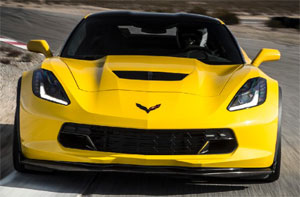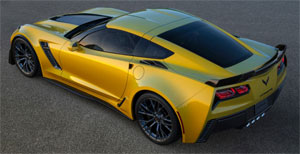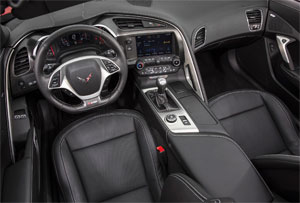2015 Chevrolet Corvette Z06
The all-new 7th generation Chevrolet Corvette Stingray is a terrific sports car. But, it’s just the beginning to the latest Corvette chapter. No sooner did we drive the Stingray then Chevy started teasing us with their next installment: the Z06! It’s been a year of waiting. But, now the wait is over.
Truth be told, we would have done just about anything to get some track time in the 2015 Chevrolet Corvette Z06. Turns out all we had to do was say yes to Chevrolet’s invitation and hop on a plane to Spring Mountain Motorsports Ranch near Las Vegas, Nevada.
What awaited us there was 650–horsepower worth of torqued up Corvette ready to romp and roll.
Easing up to speed on the track, this Z06 has a familiar feel that any Corvette owner would quickly recognize. As we became more attuned with the track and the car, lap times started falling, tires started protesting, and smiles became perma-blasted on our faces.
There’s certainly a nasty streak within’ this heavily tweaked Stingray that’s more than willing to be unleashed.
 The Z06’s aluminum chassis is, for the first time, produced in house at Bowling Green Corvette Central. And, due to its extremely stiff nature, no further updates are needed for the C7.R race car.
The Z06’s aluminum chassis is, for the first time, produced in house at Bowling Green Corvette Central. And, due to its extremely stiff nature, no further updates are needed for the C7.R race car.
The short/long arm, double wishbone, transverse composite spring suspension design carries over from the Stingray, but gets recalibrated; and standard Magnetic Ride Control takes care of the rest.
For those more interested in track time than cruise time, a Z07 performance package elevates things to a whole new level. It includes additional and adjustable aero-elements for greater downforce, carbon-ceramic brake rotors, and Michelin Pilot Sport Cup 2 tires. Helping maintain that unreasonable amount of grip is Performance Track Management and a multi-mode electronic limited slip differential.
Giving power to these random acts of performance is a 6.2-liter LT4 V8 with plenty of extra massaging done by the powertrain professionals at GM’s Tonawanda engine shop. And thanks to a first ever in a Z06 supercharger, output is 650–horsepower and 650 lb-ft. of torque. Expect 0-60 times to be under 3-seconds, of course. You can stick with the standard rev-matching 7-speed manual transmission, or opt for a paddle shifted 8-speed automatic.
 You’ll have no problem picking this smooth criminal out of a line-up, as Chevrolet has tacked on a wealth of add-ons in the name of ultimate down-force creation. If you like your performance cars to be a little subtle, look elsewhere. Meanwhile we’ll be taking a 2nd and 3rd look at this ‘vette’s wacked out lines and performance enhancements.
You’ll have no problem picking this smooth criminal out of a line-up, as Chevrolet has tacked on a wealth of add-ons in the name of ultimate down-force creation. If you like your performance cars to be a little subtle, look elsewhere. Meanwhile we’ll be taking a 2nd and 3rd look at this ‘vette’s wacked out lines and performance enhancements.
There are new fascias front and rear, a front splitter, unique hood, and rear spoiler. And of course all of those aero elements; some standard, some part of the carbon-fiber aero package, and some part of the Z07 package.
The fenders are extended 2-inches in front, 3-inches in the rear; to cover the wheels wearing 285/30/19 rubber in the fore, and 335/25/20 aft. If you don’t opt for the Z07 Performance Package, you’ll still be happy with the standard 14-inch steel Brembos.
Unlike before, the body is not hardtop only, rather the customary removable roof panel arrangement of the standard Stingray, and even a convertible is available this time around.
Inside, there are the unique colors, carbon fiber treatment, and the flat-bottomed steering wheel embellishments that you might expect; but what you might not be prepared for is the available luxury type amenities like high-end leather, 8-inch MyLink with navigation, and Bose audio.
 And by now you’ve probably heard of the available onboard Performance Data Recorder developed by Cosworth. Which consists of a high-def. camera in the windshield header, a telemetry recorder with GPS, and an SD recorder. Essentially, it provides you with motorsports-level telemetry and allows you to record your exploits for bragging rights, or perhaps for evidence.
And by now you’ve probably heard of the available onboard Performance Data Recorder developed by Cosworth. Which consists of a high-def. camera in the windshield header, a telemetry recorder with GPS, and an SD recorder. Essentially, it provides you with motorsports-level telemetry and allows you to record your exploits for bragging rights, or perhaps for evidence.
But even with all of the Z06’s capabilities and track-ready tech, street time is almost equally as rewarding as track time. Ride quality can be smoothed out with a turn of the dial, and seats offer enough comfort to seek out car shows at distant locals.
The 7-speed manual’s Government Fuel Economy Ratings of 15-City, 22-Highway, and 18-Combined will allow you to eat up plenty of miles or laps before pit stops are necessary. The 8-speed auto however, at 13-City, 21-Highway, and 16-Combined will get you a Gas Guzzler tax.
Still, base pricing of $78,995 clearly puts the Z06 in a class of its own, well below its purely exotic rivals. Convertibles sticker for 5-grand more. No other car on the road can even come close to matching this car’s level of performance for the price.
So while the 2015 Chevrolet Corvette Z06 may have been the ride we were eagerly looking forward to the most, and Chevrolet was gracious enough to oblige, AND it was everything we hoped it would be; it did get us thinking a bit… how awesome would a new ZR1 be?
Specifications
- Engine: 6.2 liter
- Horsepower: 650
- Torque: 650 lb-ft.
- 0-60 mph: 2.9 seconds
- EPA: 15 mpg city/ 22 mpg highway
2024 Toyota Land Cruiser
Toyota’s Go Anywhere Globetrotter Returns To U.S.
Every once in a while, we all need a reset. A time to get back to basics and prioritize the things that really matter. Well, for the Toyota Land Cruiser that time is now. So, let’s find out if that means bigger and better things for Toyota’s iconic off-roader.
The Toyota Land Cruiser’s status among the global off-road community is legendary, and it’s hard to imagine there’s any corner of the earth where a Land Cruiser hasn’t kicked up a little dust or mud. Well, 2024 sees the return of the Land Cruiser to the U.S. market after a 3-year hiatus, getting a major reset for the journey.
The reset comes mostly by no longer being based on the large three-row “300-series” chassis, but a new version of the smaller “200-series,” now known as the J250. As with the latest Tacoma, it uses the Tundra pickup’s full-size steel frame.
While the main Land Cruiser model, which goes by simply Land Cruiser, is packed full of luxury and convenience features, there is also a stripped-down model known as the 1958, honoring the first year the Land Cruiser made landfall here in North America. And it is that 1958 we have here, and we were glad to see it, as it also celebrates the original’s back-to-basics approach as a blank canvas for you to personalize as you tackle more and more adventures.
Not that it’s fully stripped down, as 8-inch touchscreen infotainment, a 7-inch full-color multi-information display, and automatic climate control are still standard. Plus, some seriously durable materials, and great heated cloth front seats that throw off some get serious 1990s Tacoma vibes.
But outside, there’s a definite lack of flashy trim and basic looking 18-inch wheels with Yokohama Geolander all-season tires; plus, big chunky bumpers and tilt-up back glass, which is a rarity that we appreciate. Though there is a little too much plastic in places that are sure to see some abuse if you do any significant off-roading.
It even feels a little rough around the edges, but for us it just adds to the rugged old-school utility vibe in a good way.
We did just that, both here in the Mid-Atlantic as well as in the California desert; and while there are some tech-forward driving aids, the actual hardware is in most cases plenty to get things done. That includes standard full-time dual-range four-wheel-drive, locking center and rear diffs, and 8.7-inches of ground clearance. A front stabilizer bar disconnect is also available to allow for increased articulation.
Who needs a V6 or even a V8 when you’ve got Toyota’s i-FORCE MAX setup at your disposal with 326 horsepower and 465 lb-ft of torque coming from a 2.4-liter turbo-four with an electric motor sandwiched between the engine and its eight-speed automatic transmission. Low speed torque delivery is impressive. It even feels a little rough around the edges, which may be a turn off to some, but for us it just adds to the rugged old-school utility vibe in a good way.
And it certainly feels quicker than an off roader needs to be, with an instant torque dump as soon as we eased on the throttle at our Mason Dixon test track; helping us get to 60 in 8.1 seconds and through the quarter-mile in 16.3 seconds at 86 mph. Considering the Land Cruiser’s terrain conquering mission, it behaved quite well in our handling course; it was plenty responsive to inputs, with less body roll than we expected and plenty of grip from the tires. The steering was light and quick but as expected didn’t provide much feel. Other than significant nosedive, braking performance was exceptional. Only 107-feet to panic stop us from 60 mph.
With the shift to the smaller size, there’s no more third row available, and cargo capacity now comes in at 46.2 cubic-feet with a max of a still healthy 82.1. Now, the best part of the Land Cruiser’s return is the entry price of $57,445. That’s about 30-grand less than what the last Land Cruiser went for back in 2021.
Whether it’s over the top fashion trends, mullets, or zombies; just when you think they’re dead, they come roaring back to life. Of course, we’re much happier to see the resurrection of this 2024 Toyota Land Cruiser than any of those things. Toyota is one brand that still recognizes the value of full-framed rugged rigs and has also acknowledged that sometimes less really is more. The Godfather of Toyota off-roading is back and better than ever.







